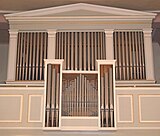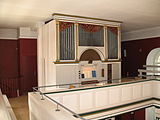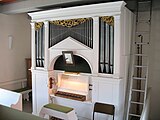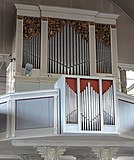Carl Giesecke (organ builder)
Carl Giesecke (born September 2, 1812 in Göttingen ; † September 28, 1888 there ) was a German organ builder who became known as a supplier of reed pipes .
life and work
Heinrich Carl August Giesecke was born as the son of the cloth maker Otto Heinrich Giesecke and Marie Caroline Aue. His grandfather and great-grandfather were surgeons in Schoningen .
Carl Giesecke learned organ building from 1840 to 1844 from Johann Friedrich Schulze , to whose style he orientated himself structurally and tonally. On April 1, 1844, he acquired citizenship in Göttingen, went into business there and was soon one of the most important organ builders in southern Lower Saxony. He initially supplied Schulze with reed registers and other organ parts. By 1860 the workshop achieved a leading position as a supplier and from 1870 only supplied reeds and organ parts. By 1869 he had built over 20 new buildings.
On July 28, 1844, he married Wilhelmine Rosine Charlotte Schulz from Hameln , with whom he had six children. His son Hermann (born May 11, 1847 in Göttingen; † February 12, 1928 there) was also an organ builder and shortly after 1880 his father's partner. According to a contractual agreement, the company has been trading as "Carl Giesecke & Sohn" since 1884. Since then Hermann has taken over the construction of the tongues, while his father only made mechanical parts. In view of the growing demand for reeds, the construction of complete organs was abandoned.
Since Hermann had no male descendants, the company was leased to Adolf Hammer in 1909, the co-owner of P. Furtwängler & Hammer . Hermann's two daughters Helene Giesecke and Gertrud Steggewentz became shareholders and the company was called "Gieseckes Erben and W. Furtwängler". The number of employees grew to over 75 after the Second World War. In 2006 the company was converted into a GmbH. In continuation of the company tradition, around 25 employees supplied organ builders worldwide with reed and labial pipes. In 2012 the company filed for bankruptcy, as a result of which the workshop was closed and business operations ceased.
List of works (selection)
The size of the instruments is indicated in the fifth column by the number of manuals and the number of sounding registers in the sixth column. A capital “P” stands for an independent pedal, a lowercase “p” for an attached pedal. Italics indicate that the organ in question is no longer or only the prospectus has been preserved.
| year | place | church | image | Manuals | register | Remarks |
|---|---|---|---|---|---|---|
| 1848 | Weende (Göttingen) | St. Petri |

|
I / P | 8th | Preserved some registers |
| 1850 | Moringen | City Church | II / P | 23 | New building with integration of some registers by Christian Vater (1743); 1976 restoration by Martin Haspelmath ; Case and several registers from Giesecke have been preserved | |
| around 1850 | Oldenrode | Ev.-luth. church | I / P | 6th | New building; Housing received | |
| 1851 | Dassensen | Ev.-luth. church | I / P | 7th | Only the lower case in the parapet has been preserved | |
| 1853 | Sudershausen | St. Johannis | I / p | 7th | New building; preserved almost unchanged | |
| 1854 | Waake | Village church | I / P | 7th | New building; Housing and sub-bass 16 'received | |
| 1855 | Troughs | St. Laurence | I / P | 6th | New building; received some registers | |
| 1855 | Altenau | St. Nikolai | II / P | 15th | New building; 1965 rebuilt by Schmidt & Thiemann with a Rückpositiv (today II / P / 16) | |
| 1856 | Silkerode | St. Nicolai | II / P | 14th | New building; after 1900 reconstruction by Georg Kiessling & Sons and 2002 restoration by Schönefeld (organ building) | |
| around 1859 | Stockheim | St. Martin | II / P | 16 | New building | |
| 1860 | Scheden | St. Mark's Church |

|
II / P | 22nd | Reconstruction of the organ by Johann Dietrich Kuhlmann (1829) |
| 1862 | Bockelnhagen | Ev.-luth. church | II / P | 11 | ||
| 1863 | Rosdorf | Ev.-luth. church |

|
II / P | 28 | 1911 reconstruction by P. Furtwängler & Hammer, restored in 1997 by Werner Bosch Orgelbau |
| 1864-1865 | Goettingen | St. Mary | II / P | 18th | 1926 Most of the registers in the new building were taken over by P. Furtwängler & Hammer. |
literature
- Karl Heinz Bielefeld: organs and organ builder in Göttingen . Pape Verlag, Berlin 2007, ISBN 978-3-921140-75-8 .
- Hermann Fischer : 100 years of the Association of German Organ Builders . Orgelbau-Fachverlag, Lauffen 1991, ISBN 3-921848-18-0 , p. 193 .
- Wilhelm Furtwängler: Carl Giesecke & Sohn GmbH, Göttingen, Prov. Hanover, factory of all organ reeds. Goettingen 1928.
- Uwe Pape : Giesecke, family. In: Music in the past and present . Person part, Volume 7. Kassel, Bärenreiter 2002, Sp. 930-931.
- Klaus Wilhelm Furtwängler, Angelika Hesse: Tongues ( memento from July 15, 2012 on WebCite ). Giesecke + Sohn 1997 (PDF file; 7.35 MB).
- Uwe Pape: Carl Giesecke - organ builder and manufacturer of reed parts in Göttingen. In: Roland Behrens, Christoph Grohmann (Ed.): Dulce Melos Organorum. Festschrift for Alfred Reichling's 70th birthday (= publication by the Society of Organ Friends. Volume 200). Society of Organ Friends, Mettlach 2005, pp. 385–422.
Individual evidence
- ^ Uwe Pape: Carl Giesecke - organ builder and manufacturer of reed parts. 2005, p. 386.
- ^ Karl Heinz Bielefeld: Organs and Organ Builders in Göttingen . Pape Verlag, Berlin 2007, ISBN 978-3-921140-75-8 , pp. 356 .
- ↑ Uwe Pape: Giesecke, family. 2002, p. 930.
- ↑ a b Uwe Pape: Giesecke, family. 2002, p. 931.
- ^ Uwe Pape: Carl Giesecke - organ builder and manufacturer of reed parts. 2005, p. 388.
- ^ History. Archived from the original on July 11, 2012 ; Retrieved July 12, 2012 .
- ^ Opening of insolvency Giesecke GmbH ( memento of July 15, 2012 on WebCite ), as of July 15, 2012.
| personal data | |
|---|---|
| SURNAME | Giesecke, Carl |
| BRIEF DESCRIPTION | German organ builder |
| DATE OF BIRTH | September 2, 1812 |
| PLACE OF BIRTH | Goettingen |
| DATE OF DEATH | September 28, 1888 |
| Place of death | Goettingen |



